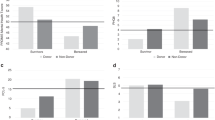Abstract
Families of 22 children preparing to undergo bone marrow transplantation (BMT) provided information concerning parent-reported major negative life stress, child coping strategies, parental psychological symptomatology, and child adjustment. Immediately prior to BMT, children and families are confronted with multiple stresses which challenge the child's coping and strain the parents' ability to assist the child with coping. Hence, stress, parental adjustment (distress), and child coping may be important factors affecting the child's overall psychological adjustment. Results showed that 15–25% of children and parents experienced clinically significant levels of psychological distress. Parent and child psychological distress were closely related. Major negative life stresses experienced by the parent and use of avoidant coping by the child significantly predicted child adjustment problems in the pretransplant period. Coping skills interventions targeting avoidant coping and management of parental stress/distress may reduce child psychosocial risk prior to BMT.
Similar content being viewed by others
References
Achenbach, T. M. (1991a).Manual for the Child Behavior Checklist/4–18 and 1991 Profile. Burlington: University of Vermont Department of Psychiatry.
Achenbach, T. M. (1991b).Manual for the Youth Self-Report and 1991 Profile. Burlington: University of Vermont Department of Psychiatry.
Andrykowski, M. A. (1994). Psychiatric and psychosocial aspects of bone marrow transplantation.Psychosomatics, 35, 13–24.
Cogliano-Shutta, N., Broda, E., & Geiss, J. (1985). Bone marrow transplantation: An overview and comparison of autologous, syngeneic, and allogeneic treatment modalities.Nursing Clinics of North America, 20, 49–66.
Compas, B. E. (1987). Coping with stress during childhood and adolescence.Psychological Bulletin, 10, 393–403.
Derogatis, L. R. (1994).SCL-90-R manual. Minneapolis, MN: NCS.
Forman, S. (1993).Coping skills interventions for children and adolescents. San Francisco: Jossey-Bass.
Gottlieb, S., & Portnoy, S. (1988). The role of play in a pediatric bone marrow transplantation unit.Children's Health Care, 16, 177–181.
Hollingshead, A. B. (1975).Four factor index of social status. Working Paper.
Kanner, A. D., Coyne, J. C., Schaefer, C., & Lazarus, R. S. (1981). Comparison of two modes of stress measurement: Daily hassles and uplifts versus major life events.Journal of Behavioral Medicine, 4, 1–39.
Kazdin, A. (1990). Assessment of childhood depression. In A. M. LaGreca (Ed.),Through the eyes of the child: Obtaining self-reports from children and adolescents (pp. 189–233). Boston: Allyn & Bacon.
Kovacs, M. (1992).Children's Depression Inventory Manual. North Tonawanda, NY: Multi-Health Systems.
Kronenberger, W. G. (1993).The Child Observed Coping Scale, unpublished manuscript.
Kronenberger, W. G., Carter, B. D., Morrow, C., Stewart, J., Martin, K., & Sender, L. (1993).Stress, coping, and the psychological adjustment of children undergoing bone marrow transplantation. Paper presented at the Fourth Florida Conference on Child Health Psychology, April.
Lazarus, R. S., & Folkman, S. (1984).Stress, appraisal, and coping. New York: Springer.
Mulhern, R. K., Fairclough, D. L., Smith, B., & Douglas, S. M. (1992). Maternal depression, assessment methods, and physical symptoms affect estimates of depressive symptomatology among children with cancer.Journal of Pediatric Psychology, 17, 313–326.
Murch, R. L., & Cohen, L. H. (1989). Relationships among life stress, perceived family environment, and the psychological distress of spina bifida adolescents.Journal of Pediatric Psychology, 14, 193–214.
Perrin, E. C., Stein, R. E. K., & Drotar, D. (1991). Cautions in using the Child Behavior Checklist: Observations based on research about children with a chronic illness.Journal of Pediatric Psychology, 16, 411–421.
Phipps, S. (1994). Bone marrow transplantation. In Bearison, D. J., & Mulhern, R. K. (eds.),Pediatric psychooncology: Psychological perspectives on children with cancer. New York: Oxford University Press.
Phipps, S., & DeCuir-Whalley, S. (1990). Adherence issues in pediatric bone marrow transplantation.Journal of Pediatric Psychology, 15, 459–475.
Pot-Mees, C. (1989).The psychosocial effects of bone marrow transplantation. Delft, The Netherlands: Eburon.
Pot-Mees, C., & Zeitlin, H. (1987). Psychosocial consequences of bone marrow transplantation in children: A preliminary communication.Journal of Psychosocial Oncology, 5, 73–81.
Sanger, M. S., Copeland, D. R., & Davidson, E. R. (1991). Psychosocial adjustment among pediatric cancer patients: A multidimensional assessment.Journal of Pediatric Psychology, 16, 463–474.
Sarason, I. G., Johnson, J. H., & Siegel, J. M. (1978). Assessing the impact of life changes: Development of the Life Experiences Survey.Journal of Consulting and Clinical Psychology, 46, 932–946.
Spirito, A., Stark, L. J., & Williams, C. (1988). Development of a brief checklist to assess coping in pediatric populations.Journal of Pediatric Psychology, 13, 555–574.
Stuber, M. L., Nader, K., Yasuda, P., Pynoos, R. S., & Cohen, S. (1991). Stress response after pediatric bone marrow transplantation: Preliminary results of a prospective longitudinal study.Journal of the American Academy of Child and Adolescent Psychiatry, 30, 952–957.
Tarnowski, K. J., Rasnake, L. K., Linscheid, T. R., & Mulnick, J. A. (1989). Behavioral adjustment of pediatric burn victims.Journal of Pediatric Psychology, 14, 607–616.
Thompson, R. J., Jr. (1985). Coping with the stress of chronic childhood illness. In A. N. O'Quinn (ed.),Management of chronic disorders of childhood (p. 11–41). Boston: G. K. Hall Medical.
Wallander, J. L., Varni, J. W., Babani, L., Banis, H. T., & Wilcox, K. T. (1989). Family resources as resistance factors for psychological maladjustment in chronically ill and handicapped children.Journal of Pediatric Psychology, 14, 157–173.
Author information
Authors and Affiliations
Rights and permissions
About this article
Cite this article
Kronenberger, W.G., Carter, B.D., Stewart, J. et al. Psychological adjustment of children in the pretransplant phase of bone marrow transplantation: Relationships with parent distress, parent stress, and child coping. J Clin Psychol Med Settings 3, 319–335 (1996). https://doi.org/10.1007/BF01994017
Issue Date:
DOI: https://doi.org/10.1007/BF01994017




